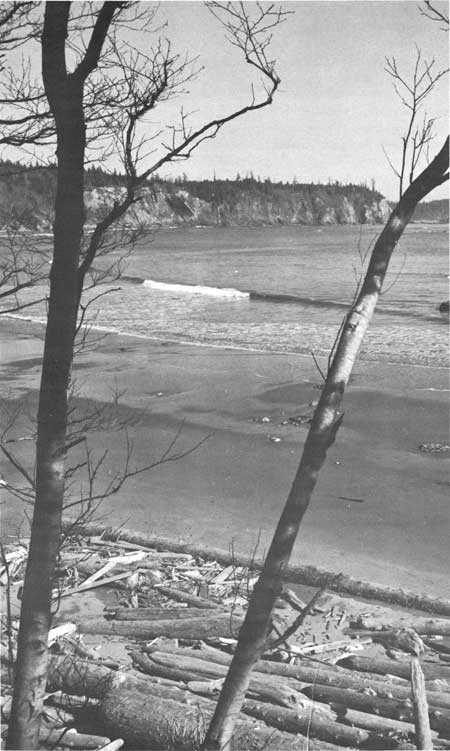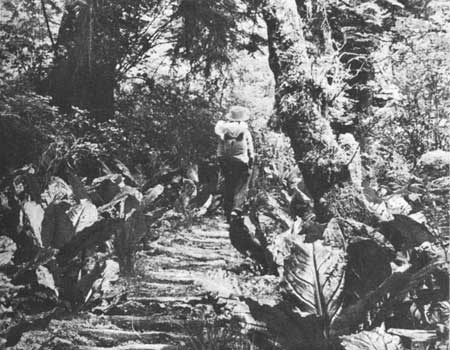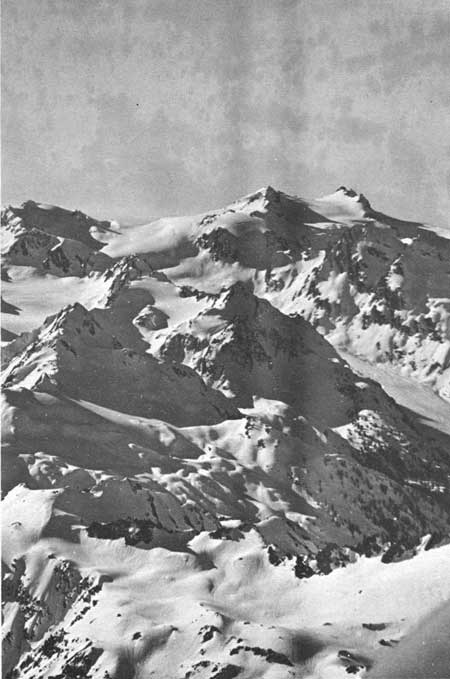|
OLYMPIC National Park |
 |
Man in Olympic
INDIANS OF THE OLYMPIC PENINSULA
In aboriginal times, the Olympic Peninsula was a part of the Northwest Coast cultural area, which stretched along the Pacific shoreline from northern California to Alaska. The inhabitants of this extensive region shared many cultural traits, perhaps the most distinctive of which were a keen sense of personal property and a veneration of wealth. These people did little to change their natural environment, but they showed great skill in utilizing what resources their primitive technology made available. Their dug-out canoes, for instance, fashioned from tree trunks, were probably the finest which have ever been made by any aboriginal people.
This remarkable culture was possible largely because the environment provided an abundance of the necessities of life. Food was easily obtained, and 3 or 4 months of gathering provided enough for the balance of the year. Fish were the staple food. Salmon swarmed up the streams of the Olympic Peninsula each summer and were trapped or speared in great quantity. Smelt were dipped from the surf, and clams and other shelled creatures were taken from the seashore. The diet was augmented by berries and roots from the wood lands. Elk, deer, and birds provided meat. Some of the Olympic Indians hunted seals, porpoises, and whales. The capture of the whales required daring journeys on the open sea in dug-out canoes 30 to 40 feet long and accommodating 6 to 8 men.
The great forests of the Peninsula were vitally important to the Indian economy. Cedars provided hulls for canoes or were split into planks for houses. From cedar bark were made baskets, mats, sails, cordage, clothing, and other household necessities.
Most of the year these Indians lived in villages located above the beaches along the ocean or arms of the sea, generally at the mouths of rivers. Their permanent houses were stoutly built of planks. Some of these rectangular structures, designed to accommodate several families, were more than 60 feet long and 30 to 40 feet wide. Many of them were beautifully decorated with painted designs. During summer it was a common practice of these people to migrate, either inland to gather berries and hunt, or along the watercourses to fish.
By primitive standards, the Indians of the Northwest Coast were wealthy; that is, they had plenty of things to eat, wear, and use for shelter. They also had much winter leisure. This combination of wealth and leisure gave rise to a remarkable political and social system in which power and prestige generally belonged to the richest individuals.
An important feature of the social structure was the giving away of possessions during a feast, called a potlatch. Years, even a lifetime, of saving and privation were frequently endured in order to accumulate sufficient wealth for this purpose. Guests were invited from many tribes. The host gave such valuable gifts as canoes, slaves, food, fishing equipment, and, in more recent years, commercial blankets. As a rule, gifts were given only to guests who could afford to give a return potlatch. Gift-giving was a good investment for the host because the recipient was obligated to give a larger gift in return. This act of giving away one's possessions elevated the giver and his family in the social scale. Wealth was measured not so much in terms of what was owned as by what was given away.
In recent years the Bureau of Indian Affairs has exerted pressure to discourage the potlatch system, and it has declined greatly; but potlatches are still held in modified form.
Today, the scene at Indian villages along the Olympic Peninsula is quite unlike that of a century ago. The cedarplank communal houses are no longer built; and, as the climate is not conducive to preservation, the old ones have disappeared. White man's clothes have replaced garments of skin and shredded bark. Customs, too, have been modified under the impact of modern civilization. Still, much of the old Indian tradition survives, though it may not be discernible on the surface.
The main source of livelihood still is fishing. The Indians prefer to use dug-out canoes, but now these are usually propelled by outboard motors. Nearly every family owns a canoe, although only a few expert canoe makers build them. They are similar to the oldtime canoes in design, but the tools used to carve them are steel rather than the stone, shell, or bone used for blades in primitive tools.
Thrilling dug-out canoe trips on the Quinault River are available in summer for a moderate fee. The Quinault Indians at Amanda Park, where the river flows out of Lake Quinault, offer such trips over the entire distance of 35 miles to the ocean.
 THIRD BEACH, BORDERED WITH DRIFTWOOD, IS ACCESSIBLE BY TRAIL. |
EXPLORATION BY SEA
The first white men to explore the Olympic Peninsula came by sea. Spanish navigators venturing northward from Mexico may have coasted the shoreline as early as the 16th century. Juan de Fuca, said to have been a Greek pilot in the service of Spain, claimed to have entered the strait, which bears his name, in 1592, but satisfactory proof of this discovery is lacking.
Extensive exploration of the Northwest Coast did not begin, however, until the latter part of the 18th century, when rumors that the Russians were venturing southward from Alaska stirred the Spaniards to fresh efforts. In 1774, during the first of these renewed voyages, Juan Perez saw the present Mount Olympus and named it "Santa Rosalia." He was the first European to name a geographic feature in what is now the State of Washington.
During the next 25 years the Northwest Coast, including that of the Olympic Peninsula, was widely explored and mapped by Spaniards, Englishmen, and Americans. The Spaniards were the first actually to set foot on the Peninsula. During a voyage made by Bruno Heceta and Juan de la Bodega y Quadra in 1775, Heceta landed at Point Grenville, near the mouth of the Quinault River.
Capt. James Cook was the first of several English navigators to explore the Northwest Coast. In 1778, during his search for the Northwest Passage, he named Cape Flattery, in the northwest corner of the Olympic Peninsula. While on the coast, some of Cook's crew men obtained furs from the natives and later sold them in China for high prices. This event turned the eyes of English and American businessmen toward the Pacific Northwest, and thereafter exploration of this region was stimulated by the fur trade.
In 1788, Capt. John Meares, an English trader, saw the mountain which Perez had named 14 years earlier. Not knowing of the earlier discovery, he christened the peak "Mount Olympus."
 THE INDIAN VILLAGE TRAIL THROUGH A SWAMP. |
Juan Francisco de Eliza, a Spanish captain, entered Juan de Fuca Strait in 1791 and named the harbor, where present Port Angeles is situated, "Puerto de Nuestra Senora de Los Angeles," which means "Port of Our Lady of the Angels." In the following year the Spaniards established a fort and settlement at Neah Bay. The members of this colony, which existed for only 5 months, were the first white settlers to touch the soil of the Olympic Peninsula and, indeed, of the State of Washington.
In 1792, Capt. Robert Grey, an American trader, discovered the harbor at the southern margin of the Olympic Peninsula which was later named in his honor. Of all the explorers who came by sea, George Vancouver, the English navigator, left the greatest mark in northwest Washington. He explored Puget Sound waters in 1792 and named numerous geographic features, including Port Townsend and Discovery Bay, on the Olympic Peninsula.
EXPLORATION BY LAND
At the same time that maritime traders and explorers were making known the features of the coast, other adventuresome men were opening overland trails into the Northwest. By 1810, fur traders following in the wake of Alexander Mackenzie, David Thompson, and Lewis and Clark were well established in the present British Columbia and in the Columbia River drainage basin. After 1821, the British-controlled Hudson's Bay Company dominated the fur trade of the Pacific Northwest and for a number of years virtually excluded rivals from the area.
During the 1830's and 1840's, however, American traders, missionaries, and settlers in ever-increasing numbers pushed into the Northwest. British influence declined as the American population grew, until, in 1846, Great Britain bowed to the inevitable and gave up her hopes of owning the region as far south as the Columbia River. In that year the 49th parallel was established as the boundary between American and British territory west of the Rockies.
Up to this time few American settlers had established homes on the north side of the Columbia River. Following the adjustment of the boundary dispute, pioneers rapidly pushed into the Puget Sound basin. A few of these newcomers established themselves at Port Townsend in 1851.
Although Port Townsend was the first permanent settlement on the Peninsula, two trappers named John Sutherland and John Everett had crossed the strait from Victoria in 1849 and had operated traplines on the two large lakes west of Port Angeles. One lake still bears the name of Sutherland. The other, first named Lake Everett, is now known as Lake Crescent. The first permanent settlers in the Port Angeles area did not take up claims until 1857.
Settlement of the Olympic Peninsula proceeded slowly, and the mountains remained virtually unknown for several decades despite the fact that the first ascent of Mount Olympus reportedly was made as early as 1854. The first real attempt to explore the Olympic Mountains was made in 1885 by an expedition under the leadership of Lt. Joseph P. O'Neil of the 14th Infantry. Starting at Port Angeles, the explorers cut a trail past Mount Angeles to Hurricane Ridge. They returned by the same route after investigating the country to the southeast, perhaps as far as the head of the Lillian River.
The next major expedition into the Olympic Mountains was promoted by Edmond Meany, the 27-year-old city editor of the Seattle Press. At his instigation, the paper, on October 23, 1889, carried an article calling attention to this unknown land and the need for exploration. "There is a fine opportunity," said the article, "to acquire fame by unveiling the mystery which wraps the land encircled by the snow-capped Olympic range.
Meany persuaded the Press to finance an expedition, and a party was organized, with James H. Christie, former hunter, Indian fighter, and arctic explorer, as its leader. The company started up the Elwha River in December 1889. It was believed that the mountains visible from the coast were but an outer rim within which there was a central valley, and by making a winter start the expedition hoped to be over the first range and ready for work in the valley when spring should come. This ignorance concerning the true character of the mountains might have brought a tragic ending to the expedition had the explorers not been experienced and resourceful in wilderness travel.
Six months later the party emerged from the mountains at Lake Quinault, having endured severe hardships and privations without any serious mishap. They had blazed a crude trail across the heart of the unknown Olympics. They brought back photographs and a rough topographic map of the country. They reported on its plants, animals, and minerals, and they named 50 peaks, rivers, lakes, and other land marks. Many of these names remain today. Press Valley, on the Elwha, was named for the newspaper which financed the expedition, and the Bailey Range was named for William H. Bailey, the paper's proprietor. Mount Meany perpetuates the name of the young city editor, and Mounts Christie and Barnes honor, respectively, the leader and narrator of the expedition.
The Press explorers had been out of the wilderness but a few weeks when another expedition was organized. The Oregon Alpine Club furnished a scientific staff and much of the money; the Army supplied Lieutenant O'Neil to lead the party and soldiers to assist. During the summer of 1890 this expedition crossed the Olympic Mountains from Hood Canal to Lake Quinault by way of the Skokomish and Quinault Rivers. They, too, left names on many geographic features.
O'Neil Pass and O'Neil Creek were named for the leader, Mount Henderson for the botanist of the party, and Mount Bretherton for the naturalist-cartographer. In his report O'Neil stated, "while the country on the outer slope of these mountains is valuable, the interior is useless for all practicable purposes. It would, however, serve admirably for a national park."
These expeditions stimulated settlement on the fringes of the Olympic Peninsula and in the river valleys. They also led to further exploration of the interior and to a realization of the vast recreational resources of this mountain fastness.

ESTABLISHMENT OF THE PARK
Olympic Forest Reserve was established in 1897 by Executive order, and was surveyed during the next 3 years, by Messrs. Arthur Dodwell and Theodore Rixon. They produced the first accurate map and gave a detailed account of the forests.
Efforts to preserve the Olympic wilderness started in 1904 when Representative Francis W. Cushman introduced a bill for the establishment of Elk National Park. The bill did not pass. In 1906 and 1908, Representative William E. Humphrey introduced bills to create a game refuge on the Olympic Peninsula. These bills also failed. Two days before the end of the Theodore Roosevelt administration he asked the President to set aside a National Monument in the Olympic Mountains under authority of the Antiquities Act of 1906. By Presidential proclamation, Mount Olympus National Monument was established in 1909.
The monument was within the boundaries of Olympic National Forest. From 1909 to 1933, it was administered by the Forest Service, U.S. Department of Agriculture. By Executive order, the monument was transferred to the National Park Service, U.S. Department of the Interior, on June 10, 1933.
Efforts to establish a national park in the Olympics were renewed in 1935. Representative Monrad C. Wallgren repeatedly introduced bills to have this done, but without success at first. President Roosevelt visited the Olympic Peninsula in 1937 and expressed approval of a large Olympic National Park. The act of June 29, 1938, established Olympic National Park and abolished Mount Olympus National Monument. The park now has an area of 1,400 square miles.

|

|
| NPS History | History & Culture | National Park Service | Contact |
|
Last Modified: Sat, Nov 4 2006 10:00:00 pm PST |


